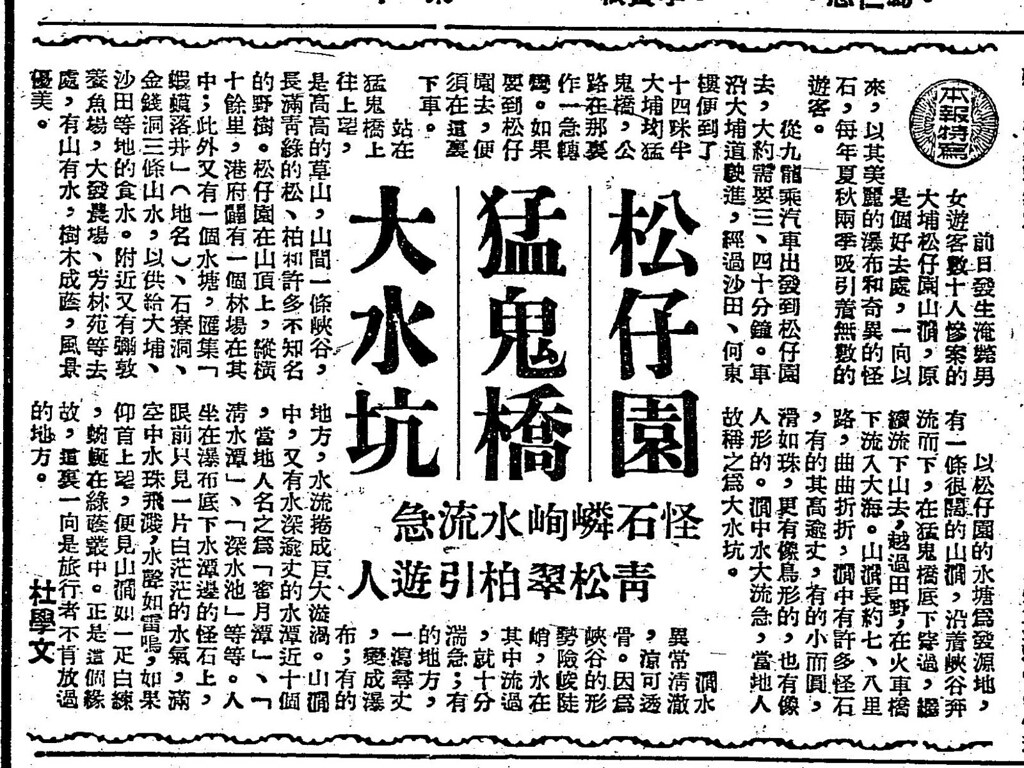¡iÂà¶K¡jªQ¥J¶é¤j®HÞ]«ã¤ô¾ô




¤j®HÞ]¡Gݯ´À¦º°
¤j®HÞ]«ã¤ô¾ôªº¡u²r°¾ô¡v¶Ç»D¡A¥i»¡¬O»´ä¨ä¤¤¤@ӳ̸g¨åªº°¬G¨Æ¡A¥¦¦ì©ó¤j®HÞ]ªQ¥J¶é¡A¥Ñ©ó¸Ó³BÄݸô¯¶Ås«æªº¥æ³q¶ÂÂI¡A¤£®É¦³¤HªP¦º©ó¨®º×·N¥~¡A©ó¬O³Q«a¥H¡u²r°¾ô¡v¤§¦W¡A§ó¦³¶Ç»D«ü¨C¨ì²`©]¡A«K¦³¥Õ¦ç¤k°©ó¸Ó³BºI¨®Ý¯´À¦º°¡I
¨ä«á¸Ó³B§óµo¥Í¤@©vºG¼@¡G¤@¤E¤¤¦~ªºª»Äõ¸`«e¤i¡A¤@¯Z®v¥Í¨ìªQ¥J¶é¥¹C¡A´Á¶¡¹J¤W¤j«B¡A¹E¨«¨ì¾ô¤UÁ׫B¡A°Z®Æ¤@³õ¤s¬x±»¦Ü¡A¤@¦æ¤G¤Q¤K¤HºG³Q¬¡®I©ó¾ô¤U¡A¦Û¦¹¡u²r°¾ô¡vªº¾x°¶Ç»D§ó¬O²r¤W¥[²r¡I
«ã¤ô¾ô¬x¬y»Fº×°O-ªQ¥J¶éªº¥Û¸O
ªQ¥J¶é¾Fªñ¤E¼sÅK¸ô¤j®HÞ]¯¸¤Î¤j®H¤½¸ô ¡A¥æ³q¤è«K¡A¦Ó¥B¨âÃä¤s®pºñ¾ð¦¨½®¡A¤¤¥¡³sºø¼Æ¤½¨½ªøªºªe·Ë¤ô¼î¡A·í¦~Áï¬ù15¦Ì¡A¥i¨Ñ¦æ¤sº©¨B¡B³¥À\¡B´åªaµ¥¬¡°Ê¡A¦¨¬°¥¹Cªº¼öªù¦aÂI¡C
¦b1955¦~8¤ë8¤éªº¤U¤È¬ù1®É30¤À¡A¤@¸s®v¥Í¥¿¦b·Ë¼î®Ç¤È¿¯¡A¬ðµM¤U«B¡A¥L̨«¨ì¾ô¼Ùªº©³³¡Á׫B¡A½Öª¾¤s¬x¬ð¦Ü¡A¤j³¡¤À¤H¨«Áפ£¤Î¡A³Q¬x¤ô¨R¨«¡A¹JÃøªÌ¸g¹L¤j¤ô´ë¡]²{¬°º°Àܤs¡^¦A³Q¨R¥X¤j®ü¡C¨Æ«áÂIºâ¡A¤@¦@28¤H¿©Ãø¡A¦ºªÌ¤¤¬ù20¤H¬O¦b¸t¶®¦Uçĸs·|¤p¾Ç´NŪ¡C¨Æ«á¤j®H¤C¬ù¶m¤½©Ò¥ß¡m«ã¤ô¾ô¬x¬y»Fº×°O¡n¥Û¸O¥H»x¦¹ºG¼@
Tai Po Kau Special Area
Location:
This area has long been popular with those especially interested in nature, including naturalists and biologists, plus those who feel a need for quiet and unspoiled surroundings. It was originally called the Tai Po Kau plantation, describing the 440 hectares of forest on the steep catchment area of the stream you see near the car park area. The height above sea level extends from 50 metres to 650 metres at the top of Grassy Hill ( Tso Shan ) .
Special features:
Woodland - The area of the reserve is 460 hectares, and covers the long-established forestry plantations. The plantations extend from the eastern slopes of Grassy Hill down to Tai Po Road. The area is heavily wooded, with more than 100 different species of trees.
Planting of the area began in 1926 when the Government first began afforestation in the New Territories. The dominant tree was Chinese Red Pine ( Pinus massoniana ) and because of that the area has come to be known locally as Tsung Tsai Yuen, meaning Pine Garden. More recently, small areas of Camphor Tree, China Fir, Taiwan Acacia and Paper-bark Tree have been planted.
There are also many interesting native species, such as the Fragrant Litsea, Giant Bean and Sweet Gum. As you walk along the quiet paths you find stretches of ground carpeted with large, brown leaves. These are from the tree called Castanopsis fissa, a good timber tree formerly much used by the Chinese in making agricultural implements such as the primitive wooden plough. Of all the special areas in Hong Kong, this one is probably the richest in variety of native species of trees.
Fauna - The nature lover who walks quietly in the forest may see many species of bird and animal. There are at least 12 common birds, including the Dove, Magpie, Chinese Bulbul and Crested Bulbul. In winter you may see owls and wagtails, while in summer there are cuckoos and black drongos. Barking deer may be heard now and then, and occasionally the civet cat, pangolin and porcupine may be seen. In late winter and early spring there are many beautiful butterflies.
Place to go:
Members of the public are welcome at all times and no permit is required. On the other hand, no barbecue pits are provided, and no fires of any kind are permitted. The prime purpose of the area is to conserve Hong Kong's native fauna and flora. Those interested in the appreciation of nature will enjoy a visit to the area, and will find a few picnic sites where they can enjoy a packed lunch. There are no cars, buses, and no pollution; there is only the pure countryside, showing how Hong Kong to be hundreds of years ago.
There are five way-marked walks you can take in the area. Four are "colour-coded walks" and the fifth is a Nature Trail. At the entrance to the Special Area, you find an information board that describes the coded walks, including the varying lengths of each. The shortest is less than three kilometres; the longest takes you 10 kilometres. You can easily switch from one coded walk to another with no danger of getting lost. It should be almost impossible to lose your way. You may also take reference of the Countryside Series Map ¡V North East & Central NT published by Survey and Mapping Office, Lands Department.
The fifth and shortest of the walks, is the Nature Trail, about one kilometre in length. There are on-site interpretation signs to introduce the points of interest and the growing habits and characteristics of various plants in the sub-tropical forest. It also brings "into focus" many plants that even the interested hiker would be likely to pass by without noticing. At the end of the two-hour walk, signs point you onto a path that leads you directly back to the vehicular road and the carpark.
The Country Code:
Visitors in country parks are asked to help keep the parks clean and prevent hill fires so that the facilities can he enjoyed by all. Nearly all of the hill fires, and certainly all the litter, can be attributed to those visitors who do not observe the country code. Fire must only be lit in the barbecue and camping places which are specially designated and clearly marked. Every bit of unwanted waste and litter must be put into litter bin or stockade or taken away by those who brought it.
How to get there:
Tai Po Kau is accessible by taking KMB buses no. 72, 72A, 73A, 74A and Green Mini-bus 28K which pass along Tai Po Road. Get off at Tsung Tsai Yuen Bus Stop and walk towards Tai Po about 50 meters to reach entrance of Tai Po Kau Nature Reserve. Enter the Nature Reserve and walk along the road for 15 minutes to reach the start of colour walks.